In this study, high manganese steel (HMS) based 40 wt.% TiC reinforced composite was fabricated by pulsed electric current sintering (PECS) process…
Effect of applied pressure on densification and mechanical properties of Fe13Mn-TiC composite produced by pulsed electric current sintering
TRẦN VĂN HIỆP1, NGUYỄN CÔNG MINH1, PHẠM VĂN THĂNG1, HOÀNG ÁNH QUANG3, LÊ MINH HẢI1 VÀ ĐẶNG QUỐC KHÁNH1,2*
1 Viện Khoa học và kỹ thuật vật liệu, Trường Đại học Bách khoa Hà Nội, Số 1, Đường Đại Cồ Việt, Quận Hai Bà Trưng, Hà Nội.
2 Trung tâm Khoa học và công nghệ cao su, Trường Đại học Bách khoa Hà Nội, Số 1, Đường Đại Cồ Việt, Quận Hai Bà Trưng, Hà Nội.
3 Trường Đại học Kỹ thuật công nghiệp Thái Nguyên, Số 666, Đường 3-2, Tích Lương, Thái Nguyên.
*Email: khanh.dangquoc@hust.edu.vn
Ngày nhận bài: 19/4/2018, Ngày duyệt đăng: 18/5/2018
TÓM TẮT
Trong nghiên cứu này, compozit nền thép mangan cao với 40 % cốt hạt TiC đã được chế tạo bằng pháp thiêu kết xung dòng điện. Hình thái học, lỗ xốp được quan sát dưới kính hiển vi điện tử quét (SEM). Các pha được phân tích bằng phương pháp nhiễu xạ Rơnghen (XRD). Ngoài ra, ảnh hưởng của lực ép đến tỷ trọng và độ cứng đã được đánh giá. Các mẫu với tỷ trọng, độ cứng cao đã được chế tạo ở nhiệt độ thiêu kết thấp hơn (1020 oC) với lực ép 60 MPa và trong thời gian ngắn (5 phút) so với phương pháp chế tạo ép và thiêu kết thông thường. Các kết quả chỉ ra rằng lực ép có ảnh hưởng đáng kể đến Fe13Mn-TiC compozit chế tạo bằng phương pháp thiêu kết xung dòng điện.
Từ khoá : thép mangan, hạt TiC, thiêu kết xung dòng điện, tỷ trọng, độ cứng
ABSTRACT
In this study, high manganese steel (HMS) based 40 wt.% TiC reinforced composite was fabricated by pulsed electric current sintering (PECS) process. The morphology and pores of the samples were analyzed with scanning electron microscopy (SEM). Phase analysis had been carried out by X-ray diffraction (XRD). The effect of applied pressure on the relative density and hardness were investigated through Archimedes s principle and Rockwell hardness test respectively. In addition, samples with nearly full density and high hardness can be obtained by PECS at a lower sintering temperature of 1020 oC under the pressure of 60MPa for a short sintering time of 5 min. The results showed that the quality of this composite was significantly affected by applied pressure in PECS process.
Keywords: high manganese steel, TiC particles, pulsed electric current sintering, density, hardness
1. INTRODUCTION
High manganese steel (HMS) also called Hadfield steel was derived from Sir Robert Hadfields discovery in 1888 [1]. Following the ASTM Standard, A-128-75a [2] allows composition of carbon and manganese to range from 1.0 to 1.4 wt.% and from 10 to 14 wt.% respectively. Owing to their excellent toughness, high wear resistance and work-hardening ability under highimpact condition [3,4], they have been widely utilized in many industries. Meanwhile, the strength of HMS is relatively lower than some alloy steels, which restricts the further extension of their applications. Besides, HMS has a great potential to become a good matrix for making metal matrix composites. In this study, titanium carbide is considered to create a good reinforcement for HMSbased matrix composite due to its special features such as high hardness, high melting temperature and high modulus.
Furthermore, TiC particles also indicate a good wettability and thermodynamic stability with Febased matrix [5,6]. Thus, the existence of TiC particles in HMS-based matrix composites will increase sharply the wear resistance, elastic modulus, shear modulus, and creep property in TiC reinforced HMS-based matrix composite [7]. Nowadays, powder metallurgy (PM) method is recognized as an advanced and economic technique to make diverse products with near-net shape parts and good quality. The powder materials could be consolidated via various processes like vacuum sintering, hot press sintering (HP), atmospheric furnace and hot isostatic pressing (HIP). However, these processes often require several hours to reach elevated temperature that causes grain coarsening of the microstructure and the decreasing on the properties of sample. In contrast, the pulsed electric current sintering (PECS), a newly developed process, could achieve full densification with minimal grain growth in a short sintering time [8].
There are many papers related to producing HMS-based matrix composite. S.W. Hu et al. reported the TiC reinforced quenched Mn13 steel composite via combustion synthesis during casting which has a hardness of 55 HRC with 40 wt.% TiC [9]. B.H. Li et al. reported that TiB2-TiC (95 wt.%) reinforced steel matrix composite was produced by spark plasma sintering [10]. The maximum hardness of the composite is 83.8 HRA (approximate 64.5 HRC). Additionally, B.H. Li et al. prepared in situ TiC particles (>50 wt.%) reinforced Fe-based composites by using ferrotitanium and carbon black powders with the combination of in-situ and spark plasma sintering and the composite has a maximum hardness of 83.2 HRA (equal to 64 HRC) [11]. Specially, Zhi Wang et al. compared the microstructure and properties of TiC-high manganese steel cermet prepared by different sintering processes [12]. Nearly full density and higher hardness can be reached by these processes at a lower sintering temperature and in a shorter sintering time. Nevertheless, there are no or a few reports and a little knowledge about the effects of sintering parameters during PECS process on densification, mechanical properties of HMS based matrix composite. Hence, the effects of applied pressure on densification and mechanical properties of HMS-TiC composite fabricated by PECS process will be investigated in the present study.
2. EXPERIMENTAL PROCEDURES
The starting HMS powders were prepared by planetary ball-milling machine in previous work [13]. The range of particle size utilized was from 20 µm to 35 µm with chemical composition as showed in Table.1. The purity of TiC powder is 99.6 % (Changsha Langfeng metallic material Co. Ltd, China) with average particle size of 4 µm.
Table 1. The chemical composition of high manganese steel powder.
| Element | Mn | C | Fe | Cr | Ni | Others |
| %.wt | 13.42 | 0.96 | 82.26 | 2.20 | 0.39 | Bal. |
The powder mixture contained 40 wt.% of TiC and 60 wt.% HMS powder. Then it was mixed in protective medium via planetary ball-milling machine during 5 hours with ball to powder ratio and milling speed were 10/1 and 300 rpm, respectively.
As-received powder was compacted into a cylindrical graphite mold with 15 mm inner-diameter. The compacted powder was fast consolidated by SPS apparatus (Labox 210, Sinterland Co. Ltd, Japan) at sintering temperature ranged from 990 °C to 1020 °C in vacuum by pulsed DC current passing through the graphite die, punches and the sample itself. The samples were held at the sintering temperature for 5 minutes. The applied pressures were held constantly from 30 MPa to 60 MPa throughout the sintering process.
The relative density of sintered samples was determined using the Archimedes’ immersion method in distilled water. Hardness was tested by a Rockwell hardness tester (HR-150A). A scanning electron microscope (SEM, Cambridge LEO-1450) was used to evaluate microstructures of the samples. The phases were identified by X-ray diffractometer (XRD, Brucker D8 ADVANCE). The wear-resistance of sintered samples was estimated through the pin-on-disc testing (TRIBOtester) where the abrasive clothes of 100 grit were used. The tests were conducted according to ASTM G133-95 standard under load of 15 N and sliding velocity of 750 mm/s. The total sliding distance covered was kept constant for every experiment, approximately 3000 m. The weight of each specimen was measured to the nearest 0.0001 g before and after the test for calculating the wear rate.
3. RESULTS AND DISCUSSION
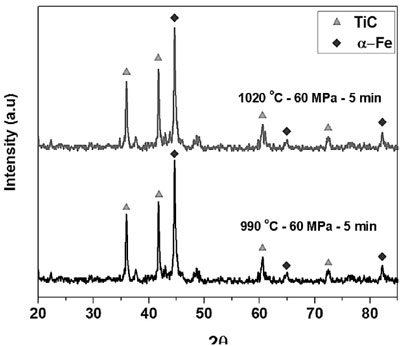
Fig. 1 showed the XRD patterns of Fe13MnTiC composite samples sintered under applied pressure of 60 MPa with different sintering temperatures of 990 °C and 1020 °C. It can be seen that there were two phases existence which are TiC, α-Fe solution and no other phase was observed. Normally, high manganese steel is austenitic, however, under intense impact condition during preparing Fe13Mn powder and mixing processes, the austenitic, γ-Fe solution phase was be transformed to martensitic, α-Fe solid solution phase [14]. The α-Fe solid solution phase was maintained for entire sintering process, there was no phase transformation.
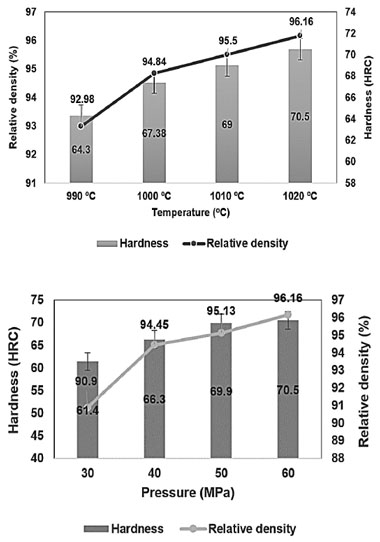
The relationship between the relative density and hardness of the samples sintered under 60 MPa pressure for 5 min with different sintering temperatures is presented in Fig. 2. Generally, it is expected that the densification increased gradually with the sintering temperature. Shrinkage °Ccurred much faster when the temperature was over 990 °C. Besides, the densification reached highest point at 96.16 % at 1020 °C. It may reflect to the strong diffusion °C curred, also the mechanical bonding between TiC reinforcement and solid solution is dramatically improved with increasing temperature.
Meanwhile, when the sintering temperature increased higher than 1020oC, the steel matrix was melted and squeezed out of the mold. It can be explained by the severe volatilization of metal owing to vacuum sintering, which results in the continuous increase of the displacement and the formation of voids in the sample [15].
Fig. 3 also showed the relationship between the densification and hardness of specimens sintered at 1020 oC for 5 min hold time with various applied pressure ranged from 30 to 60 MPa.
According to Fig. 3, the relative density also increased dramatically with the increasing of applied pressure.
The higher relative density was achieved for the sample sintered under applied pressure of 60 MPa. Evidently, the pressure has a direct mechanical effect on particle rearrangement and the destruction of agglomerates. A possible explanation for the increase in density is the better formation of new particles contacts °Ccurred when higher pressure was applied, following that the contact area between the grains increased and particles underwent extensive plastic deformation [16]. Interparticle bonds were created by deformation at the point of contacts between particles. The pressure caused localized deformation at the contacts, giving work and allowing new contacts to form as the gap between particles collapsed [17]. This can be explained by higher driving force during PECS process at higher pressure.
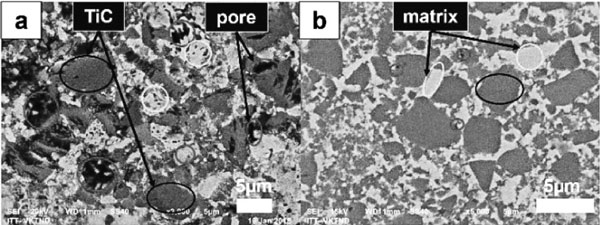
a) 990 oC – 60 MPa – 5 min; b) 1020 oC – 60 MPa – 5 min.
Fig. 4, 5 depicted SEM images of the microstructure of the polished samples prepared by different sintering processes corresponding to the Fig. 2, 3 respectively. As can be seen from the Fig. 4, 5: the dark area corresponds to pores, the grey one is TiC particles, and the bright region is the steel matrix. The TiC particles disperse uniformly in the steel matrix. Exceptionally, the Fig. 4a and Fig. 5a show many pores in some part of sample. This made the discontinuity in the steel matrix. On the other hand, the porosity of samples decreased considerably with the increasing of sintering temperature and applied pressure. It can be evidenced by microstructure images in Fig. 4 and 5 that reflected the relative density change in Fig.2 and 3 respectively.
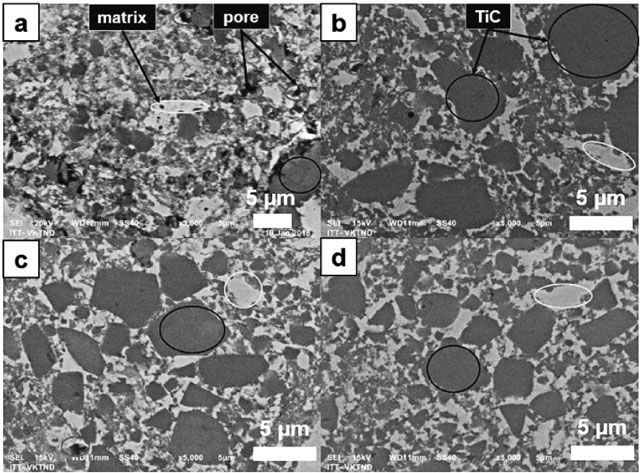
a) 30 MPa; b) 40 MPa; c) 50 MPa; d) 60 MPa.
Besides, Fig. 2 and Fig. 3 showed higher hardness of samples which contain fewer pores. Obviously, there was an increase in the hardness when the relative density ran over 90%, from 61.3 HRC to 64 HRC (according to relative density rise from 82.98 % to 91.30 % at 990 °C, 1000 °C respectively). And then, taking another jump of hardness up to over 70.5 HRC when the relative density reached over 95 % (sintered at 1020 °C, under pressure of 60 MPa). It can conclude that the porosity has strong effect to the hardness of TiC-Fe13Mn composite. On the other hand, the received high hardness is due to higher pressure and sintering temperature.
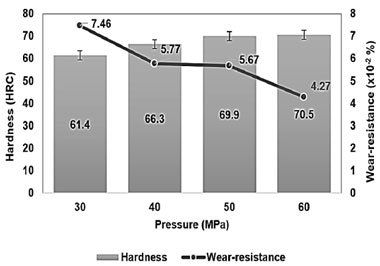
Fig. 6 presented the wear-resistance of samples sintered at 1020 °C under applied pressures ranged from 30 to 60 MPa with total sliding length of 3000 m. The wear-resistance of samples was be calculated from the mass loss results of them after completed sliding length of 3000 m. It can be seen that the all samples expressed a good wearresistance (less than 7.5×10-2 % for the total sliding length). The sample indicated the best wearresistance and also had highest hardness and relative density.
4. CONCLUSIONS
The TiC reinforced-HMS based matrix composite was fabricated successfully with nearly full relative density. The high relative density (96.16 %) and high hardness (70.5 HRC) were obtained with the sintering at 1020 °C under an applied pressure of 60 MPa for holding time of 5 min. The densification, hardness and wear-resistance of sintered samples increased with increasing an applied pressure. The sintered samples showed a good wear resistance also.
ACKNOWLEDGEMENTS
This research was supported by the Ministry of Education and Training of Vietnam through Project number B2016-BKA-23.
REFERENCES
- Hadfield R. A; Hadfield’s manganese steel, Science 12, 1888, pp. 284–286.
- ASTM A 128-75a; Annual Book of ASTM Standards, Part 2, ASTM, Philadelphia, PA, 1979, p. 95.
- Hadfield R.A; Manufacturing of steel, United states patent No.200, 1882, p. 303.
- X. Chen, W. Xiong, Z. Yao, G. Zhang, S. Chen and Q. Yang; Characterization of Ti-based solid solution cermets prepared by mechanically induced self-sustained reaction and subsequent pressure less sintering, Journal of Alloys and Compounds, 583, 2014, pp. 523–529.
- E. Pagounis, M. Talvitie, V.K. Lindroos; Influence of the metal/cermet interface on the microstructure and mechanical properties of HIPed iron-based composites, Composites Science and Technology, 56, 1996, pp. 1329-1930
- K.S. Ashok, D. Karabi; Microstructure and abrasive wear study of (Ti,W)C-reinforced high-manganese austenitic steel matrix composite, Materials Letters, 62, 2008, pp. 3947–3950.
